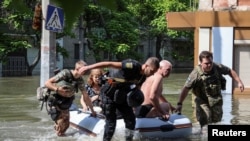On June 6, the Kakhovka dam in Russian-occupied southern Ukraine was destroyed, sparking a humanitarian and refugee catastrophe in a country already ravaged by war.
Ukrainian President Volodymyr Zelenskyy said it would have been "physically impossible” to have blown the dam up from the outside by shelling.
Ihor Syrota, head of Ukrhydroenergo, the state hydroelectric company, and others have said the dam was designed to “withstand a nuclear strike.”
In October 2022, Zelenskyy warned the Council of Europe that Russia had mined the dam. His advisor, Mykhailo Podolyak, said Russia planned to destroy the dam to flood the territory and halt a Ukrainian counteroffensive. Russia has attacked other dams during its war on Ukraine.
White House officials told The Washington Post they believed Ukraine’s counteroffensive began on June 6 and “were encouraged by better-than-expected progress.” A top Ukrainian official disputed that.
Some say the dam was not intentionally blown up but succumbed to the Russian occupiers “criminal negligence.”
The dam had already been damaged during Russia’s retreat from nearby Kherson city in November 2022, which British military intelligence pinned on Russian forces using controlled detonations.
The exact cause of the dam breach is unknown.
On June 6, the White House said it was too early to say what caused the dam to rupture.
Western media outlets have been running articles of the “what is known so far” variety. Time Magazine, for example, reported “it is unclear which nation is responsible.”
Those articles include comments from the Kremlin, which has accused the West of carrying out “a coordinated disinformation campaign” to pin the dam’s destruction on Russia.
Russian President Vladimir Putin blamed the “barbaric act” on Kyiv, saying that Ukraine’s Western curators “are still banking on the escalation of hostilities, committing war crimes, openly using terrorist methods, and organizing sabotage on Russian territory.” In other words, the same crimes international institutions and legal entities accuse Russia of committing in Ukraine.
Russian officials, state media and foreigners sympathetic to Moscow’s message have flooded the public zone with language echoing Putin’s and accusing Ukraine of sabotage.
Russian propagandists “have focused their resources on convincing the world that Ukraine destroyed the Kakhovka dam,” Joe Bodnar, analyst at the Alliance for Securing Democracy, said. Russian state media and diplomatic accounts have tweeted about the dam hundreds of times in multiple languages, “a messaging push comparable to the one around Bucha,” Bodnar noted.
Ukraine’s Center for Combating Disinformation outlined main Russian propaganda narratives about what happened with Kakhovka dam.
Most prominently, on his new Twitter television show, former Fox News Host Tucker Carlson blamed Ukraine for destroying the dam and described Zelenskyy, who is Jewish, as “rat-like.”
Throughout its invasion of Ukraine, Russia has created narratives blaming Kyiv for acts that have been persuasively attributed to Russian forces.
The Bucha Massacre? Staged.
Mass Graves in Izyum? Also staged.
The Mariupol Theater bombing? A “false flag” attack on civilians staged by the Azov regiment. And even if Russia did bomb the theater, there were “no civilians there,” but rather members of the Ukrainian military, “who set up firing points there.”
A Russian missile attack on the Amstor Mall in the central Ukrainian city of Kremenchuk? Again, Ukraine’s false flag to extort more aid from the West.
Most infamously, when a missile system from Russia’s 53rd Air Defense Missile Brigade shot down down Malaysian airliner MH17 over eastern Ukraine on July 17, 2014, Russia put out multiple, contradictory narratives.
Analysts at the RAND Corporation, a U.S. think tank and research institute, have characterized this approach as “the firehose of falsehood” model, which involves disseminating numerous and evening competing narratives intended to overwhelm the audience rather than convince them of any one truth.
Despite Moscow’s denials about alleged war crimes in Ukraine, the United Nations, international monitors, rights groups and others have accused Russia of indiscriminately shelling and bombing populated areas, killing civilians and destroying hospitals, schools, and residential buildings.
Sergiy Kyslytsya, Ukraine’s envoy to the U.N., accused Moscow of shirking its responsibility for the dam's destruction, alleging his Russian counterpart is “floundering again in the mud of lies.”





